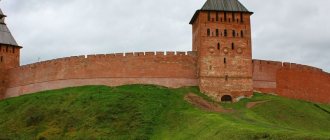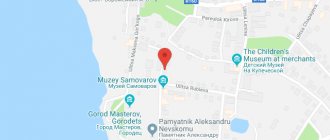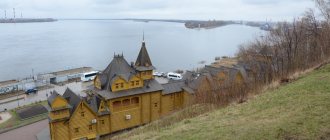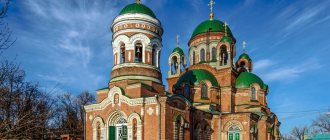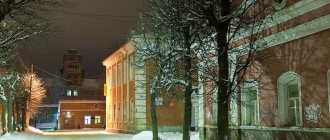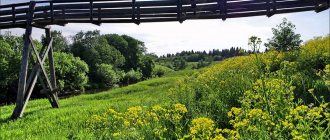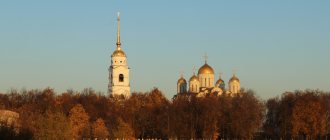The city of Lomonosov received its name in 1948; before that it was named Oranienbaum - orange tree. This is exactly what its first owner, Prince Alexander Menshikov, called this place, having received these lands as a gift from Tsar Peter. By decree of His Serene Highness, a palace was built, and to the east of it a settlement grew, where serfs, free cultivators, and artisans lived.
In the middle of the 18th century, the palace passed to the future Peter the Third, then the construction of pavilions and the laying of parks continued.
The settlement gradually grew and turned into a whole city, on the outskirts of which in 1753 M.V. Lomonosov built the only manufactory in the world that produced glass beads, mosaics and smalt. In honor of the famous scientist, the city was renamed Lomonosov in the mid-20th century.
During the war, there were defensive fortifications “Oranienbaum Piglet”. It was thanks to them that the local cultural monuments suffered much less damage than in other places near Leningrad - the Germans did not manage to capture it.
A visit to Lomonosov can be combined with a trip to Peterhof and Strelna (follow the links for reviews of interesting places in these suburbs), since they are all located nearby and on the same road.
Palace and park ensemble "Oranienbaum"
Address: Dvortsovy Ave., 48 Phone: Website: peterhofmuseum.ru Opening hours: park: 9.00-20.00, palaces: 11.00-17.00, Chinese Palace: 10.30-16.30; Closed: Tuesday. Cost: adults – 250 rubles; students - 100 rubles, preferential - 150 rubles.
The ensemble consists of the following cultural objects:
- Grand Palace. It is also called Menshikovsky, because it was it that was built as the prince’s country residence. Contemporaries said that this palace was much superior in luxury to Peterhof. It has a somewhat elongated shape: from the central building with a princely crown on the facade, two wings extend, which complete the pavilions. From here a high staircase leads to the lower garden.
- The Picture House is a small house built in the Russian Peter the Great Baroque style.
- Own dacha. It was built as a personal apartment for the future Empress Catherine the Second by the architect A. Rinaldi.
- The Chinese Palace is a two-story building with rich interior decoration. On the walls of the chambers there are picturesque panels, paintings, embroideries and drawings. The names of the rooms speak for themselves: Glass Bead Cabinet, Golden Study, Chinese Study.
- The Stone Hall is a small baroque palace designed by Rastrelli. It was built to host concerts and masquerades, and now it hosts exhibitions and concerts.
- Pavilion of the Rolling Hill. It was part of a rare structure consisting of wooden ramps, along which people rolled down in special wheelchairs and returned back using ropes.
- Lower Garden. It was laid out in the 18th century in a regular style on a ridge near the Gulf of Finland.
- Petrovsky Park is a Russian landscape park spread over 15 hectares.
- Upper Park. The park's territory is 160 hectares, with many reservoirs that are decorated with 30 bridges and footbridges.
A few facts about the city of Lomonosov
- The city was founded in 1710, until 1948 it was called Oranienbaum.
- Lomonosov is located on the shore of the Gulf of Finland, opposite Kronstadt. The cities are connected by the Ring Road, the distance between them is approximately 20 km.
- Near the city there are suburbs: Peterhof and Strelna.
- The population of Lomonosov is about 43 thousand people.
Museum of Local Lore
Address: st. Eleninskaya, 25
The museum, opened in 1974, is located in a building built in the Russian Art Nouveau style. An archive of historical materials is stored here. The museum has created an exhibition telling about the history of the city, about Lomonosov’s activities in creating the factory, about Fyodor Stravinsky.
There are also interior corners here that recreate urban life of the late 19th and early 20th centuries. The museum is currently temporarily closed to the public.
Lomonosov
During the Great Northern War (1700–1721), which was victorious for the Russian state, Russia recaptured from Sweden the lands lost in the Time of Troubles in the Baltic states (along the southern coast of the Gulf of Finland) and secured access to the Baltic Sea. In 1703, in order to strengthen the security of the conquered territory at the mouth of the Neva, Peter I founded the Peter and Paul Fortress, around which the future capital of Russia, the city of St. Petersburg, quickly developed. From the lands along the southern coast of the Gulf of Finland, which retained their historical name Ingria until 1710, the Ingermanland province was formed in 1706, which in 1710 was renamed St. Petersburg.
The new province was headed by the closest associate of Peter I, Prince A.D. Menshikov, whom the tsar instructed to build the Kronstadt fortress on Kotlin Island. Peter distributed the lands along the southern coast of the Gulf of Finland to his entourage and ordered the construction of “Funny” pleasure palaces here. The construction of the new Russian capital, numerous buildings and country palaces required a huge amount of materials and workers. By order of the tsar, peasants from the central provinces began to be resettled on the shores of the Gulf of Finland.
Founding of Oranienbaum
In 1710, Peter I gave the “most serene” Prince of Izhora A.D. Menshikov a plot on the southern shore of the Gulf of Finland along the Peterhof road, at the mouth of the Karasta River. Here A.D. Menshikov began to build his new summer estate, which, according to the prince’s plan, was to become not only a ceremonial residence, but also a profitable estate. It was planned to build a pier here that would ensure the delivery of provisions, construction materials and other goods from the mainland to Kotlin Island. The construction of brick factories and sawmills, which were supposed to produce building materials both for their own residence and for the Kronstadt under construction, also promised considerable benefits.
Along with the construction of economic buildings, the construction of “wooden chambers” for A.D. Menshikov began. The prince's first house was a one-story building with leaded windows. The house had four “light rooms” with canvas-covered walls and ceilings. In one of the rooms there was a fireplace and a Dutch-made stove; in the other there was a tiled stove.
Menshikov named his estate “Oranienbaum”, which is translated from German as an orange or orange tree. There is a legend: when the prince founded the park-estate, oranges were grown in the greenhouses of the Grand Palace. Some researchers associate the name with the name of William III of Orange - the ruler of the Netherlands and the king of England and Scotland, who was the idol of Peter I.
For the first time, the Oranienbaum estate begins to be mentioned in written sources in 1710, and the loose abbreviation “Ranibom” is more often used. Thus, “Ranibom” is mentioned in the Russian calendar of 1710. There is a mention of the estate of A. D. Menshikov in the camp journal of Peter I: “... was in the village of His Serene Highness in Ranibom”
. Therefore, 1710 is considered the year of Lomonosov’s founding.
Palace and park ensemble
In 1711, construction began on the Grand Palace under the leadership of the architect D. M. Fontana, who was replaced in 1713 by the architect I. G. Shedel. At the palace, a regular Lower Park was laid out, which was decorated with fountains, flower beds, bosquets, and sculptures. During the construction of the palace and park ensemble, a settlement of craftsmen who created the estate and peasants arose - a palace settlement, which at that time numbered 45 houses and became the core of the future city of Oranienbaum.
Construction work continued until 1727. On September 3, 1727, the solemn consecration of the palace church took place. But after just five days, Menshikov was arrested by decree of the 11-year-old Emperor Peter II, soon deprived of all positions, titles, property and sent into exile. His entire fortune, including the Oranienbaum estate with the lands and villages assigned to it, was transferred to the treasury. Palace furniture, works of art, and dishes were transferred to the palaces of the new imperial favorites.
Since 1737, a hospital was located in the premises of the Grand Palace. In 1743, Empress Elizabeth Petrovna donated the former residence of Menshikov Oranienbaum to her nephew, Grand Duke Peter Fedorovich Holstein (future Emperor Peter III). After 1745, a new stage began in the development of Oranienbaum. At this time, palaces and parks were intensively built according to the designs of the architect Antonio Rinaldi: “Peterstadt” for Pyotr Fedorovich and “Own Dacha” for his wife Ekaterina Alekseevna, Princess of Anhalt-Zerbst, future Empress Catherine II. During this construction, the palace settlement also developed.
In the 18th century, Oranienbaum often became the site of solemn celebrations, masquerades and fireworks, to which court nobility and foreign guests were invited.
On July 9, 1762, in the Japanese Pavilion of the Grand Palace, Peter III was forced to sign his abdication of the throne in favor of his wife, who was proclaimed Empress Catherine II.
Oranienbaum in the status of a city - district and provincial
In 1764, Catherine allowed foreigners of different classes to settle in Russia, providing various benefits for this. Numerous German colonies began to appear on the territory of the Russian state. They were also founded on the coast of the Gulf of Finland - Oranienbaumskaya, Krostadtskaya and others.
During the reform of the administrative-territorial division of the Russian Empire, carried out in 1775–1785, the Oranienbaum district was formed in the St. Petersburg province in 1780, and the Oranienbaum palace settlement was given the status of a district town. A county government was established here, and other institutions required by a county town appeared. On May 7 (18), 1780, the coat of arms of Oranienbaum was supremely approved: “In a silver field there is an orange tree with its fruits”
. In 1783, in the empty building of the palace of the former Emperor Peter III, the district treasury with a money depository was located - tax payments, government and other sums from Kronstadt and Peterhof were deposited here.
Since 1784, the development of Oranienbaum was carried out according to a regular plan, signed by the architect Ivan Mikhailovich Lem, which was based on a geometric grid of streets intersecting each other at right angles. According to data for 1784, the area of Oranienbaum was 41 tithes 2,040 square fathoms, and the city had 616 inhabitants. Along with the palace buildings, there were about 60 mostly wooden philistine houses in Oranienbaum. The district status of the city placed increased demands on its appearance. Work began on improving the city, repairing roads, and building bridges. In 1786, a public school was opened in Oranienbaum in a specially built two-story building. The construction of the House of Public Places began.
The further growth of the city was largely facilitated by the development of industry and the emergence of new enterprises. Back at the beginning of the 18th century. local resources were used to produce bricks, and in 1784, near the city, at Sinyavin’s dacha, the first brick factory built by English entrepreneurs began operating. In 1786, Joseph Galtieri and Felix Silka founded a chisyan and trellis factory in Oranienbaum.
In the vicinity of Oranienbaum there were numerous dachas of St. Petersburg dignitaries. In the city itself there was a salt store, wine shops, a court stone church of St. Panteleimon, as well as two wooden churches: the cemetery Holy Trinity Church in the Trinity Settlement and the Lutheran Church at the lower pond. Residential buildings of the same type combined well with the palace and park ensemble and public buildings. Most of the residential buildings have not survived to this day.
Thanks to Oranienbaum's proximity to the Baltic Fleet base - Kronstadt, the city soon became the main hospital for Russian sailors. In 1787, a naval hospital was founded here.
In 1794, the city's population was 957 people, and its area reached 72 acres of 1,000 square meters. fathoms. There were about 130 wooden and stone houses in the city.
In 1796, Emperor Paul I lowered the status of Oranienbaum, making him supernumerary. In 1797–1801 the provincial town of Oranienbaum with its palace residence belonged to Grand Duke Alexander Pavlovich (future Emperor Alexander I) with government under the authority of the Senate. To maintain order in palaces and parks and to protect them, a Palace Administration is created. Since 1802, with the accession of Alexander I, Oranienbaum was returned to the status of a county town, in which it remained until 1848.
In the first quarter of the 19th century. According to the designs of the famous architect Vasily Petrovich Stasov, who worked as part of the commission for the reconstruction of the city, created in 1815, the barracks of the guards invalid company, as well as three houses for gardeners and craftsmen apprentices, were built in Oranienbaum. In 1829, stone city gates were built according to the design of the architect Alexei Maksimovich Gornostaev.
In 1831–1873 Oranienbaum was in the possession of Grand Duke Mikhail Pavlovich (until 1849) and Grand Duchess Elena Pavlovna Romanov. The next owners of Oranienbaum (1873–1917) were the Dukes of Mecklenburg-Strelitz.
In 1848, the district administration from Oranienbaum was transferred to Peterhof, and from 1849 until the February Revolution of 1917, Oranienbaum was listed as a provincial town in the Peterhof district, first (until 1875) under the authority of the Ministry of the Imperial Court, and then the provincial department. The city administration was carried out by the City Council and the Police Department.
In 1850, the land along the shore of the Gulf of Finland was sold to the Zarya shipping company for the establishment of a steamship service between Oranienbaum, Kronstadt and St. Petersburg, and a pier was built here. In 1864, a railway line was built to the city, connecting Oranienbaum with St. Petersburg. Construction of the railway station and service buildings began, and regular passenger train service began. During this period, the station square was formed, next to which a garden with a summer theater appeared. On Palace Avenue, the main thoroughfare of the city, beautiful stone houses with shops, hotels, taverns, government offices and departments were built. The city has noticeably transformed: stone bridges, sidewalks, and boulevards were built mainly with donations from homeowners and merchants.
In the 19th century, Oranienbaum became a popular vacation spot for St. Petersburg dignitaries, scientific and cultural figures. At the end of the century, an officer rifle school operated in the city, where they carried out extensive research work in the field of shooting theory and the creation of small arms. In 1891, a new domestic original rifle by S.I. Mosin was successfully tested at a school shooting range.
The city at the end of the 19th – beginning of the 20th centuries.
At the turn of the 19th and 20th centuries. Oranienbaum was a small town. There were schools, libraries, a cinema, and a people's house here. Most of the city's residents had income mainly from renting out rooms to garrison officers, as well as to summer residents from St. Petersburg and Kronstadt. The poor washed clothes and worked as laborers. In 1896, the population of Oranienbaum reached 4,786 inhabitants; there were 300 houses in the city, but only 50 of them were made of stone. An average of 2 houses were built in the city per year. In 1908, a city power plant was built and electric lights appeared on the streets. In 1909, the city theater was rebuilt, which could now accommodate 1,400 spectators.
There was no bank in the city; financial transactions were carried out by the Peterhof district treasury. There was no large-scale industry in Oranienbaum; small enterprises operated: a lumber exchange, a sawmill, a brick factory in Martyshkin, a steam mill, handicraft workshops (metalwork, blacksmithing, plumbing, shoemaking, tailoring, hatting, etc.). There were eight Orthodox churches, a Lutheran and Finnish church, a synagogue, a convent, and a sect of evangelists.
Merchants kept trading enterprises in the city: grocery, meat, vodka, bakeries, tobacco, manufacturing, book, stationery, hardware store, officer supplies, jewelry, mosquito store, wine cellars, hairdressers, funeral procession bureaus, photo salon, pharmacies. The market and Gostiny Dvor were open. There were several hotels, taverns and restaurants in the city: “Russia”, “Venice”, “Petrogradskaya”, “Yar”, “Petersburg”, “Bear”, a Greek cafe, a temperance society tea house, a buffet restaurant at the railway station, beer houses.
There were four schools in Oranienbaum - a ministerial one-class school, city men's and women's schools, and a parochial school. Charitable institutions included: a charity home for orphans, a children's shelter for the poor, maintained with funds from the Mecklenburg-Strelitz family, an almshouse, and a home for the disabled. In the healthcare sector there were: a city hospital with therapeutic, surgical and infectious diseases departments, a dental office, and a maternity ward at an orphanage. In addition, doctors treated patients at home.
The city had developed telephone and telegraph communications. There were telephones in all government agencies, shops, hotels, restaurants, some apartments and private houses. There was a functioning water supply system, but water was also transported by horse and was also taken from wells. Some of the roads in Oranienbaum were paved with cobblestones, and some had a sand and gravel surface.
The city was adjacent to the estate of the Dukes of Mecklenburg-Strelitz and the Princess of Saxe-Altenburg, which included the Grand Palace, the Chinese Palace, the Palace of Peter III, the Rolling Hill, the Lutheran Church, the Cavalry Corps, the Picture House and other buildings. Exemplary order was maintained in the Upper and Lower parks, and many rare plants and flowers were planted. Beautiful white swans swam on all the ponds, with the exception of Red. Sculptures were installed in the parks. Entrance here was free, with the exception of the Chinese Palace, where Princess Helena of Saxe-Altenburg lived. A boat station was set up on the Red Pond, where any visitor could rent a boat. You could take a boat to the Drawing Bridge; here was a forester’s house where a dairy farm worked. The farm was equipped with tables for tea; vacationers bought milk and tea in samovars. Whole families would come here on weekends.
The protection of palaces and parks and the maintenance of order in them was carried out by the police, who were under the jurisdiction of the palace administration. The palace administration also had its own forestry department for caring for forest lands and cleaning parks. The forestry department, which was responsible for cleaning parks and caring for forest lands, maintained a small zoo. At the palace administration there were also greenhouses with greenhouses and an orchard where flowers, peaches, grapes, oranges, palm and laurel trees, plums, apple trees, etc. were grown.
In guidebooks of that period, Oranienbaum was usually noted as a quiet and cozy city, buried in lilacs.
During the years of revolution and civil war
By 1917, the population of Oranienbaum reached 7 thousand people. On February 27, 1917, after receiving news of the February Revolution that had begun in Petrograd, the First Reserve Machine Gun Regiment stationed in the city rebelled. The soldiers shot 12 officers and moved to Petrograd. In Peterhof and Strelna they united with the rebel units and the next day arrived in Petrograd.
In mid-March, the first Bolshevik organizations appeared in Oranienbaum. In April, a unified Oranienbaum Council of Workers' and Soldiers' Deputies was created. In 1918, Soviet power was established in the city.
By decree of the Council of People's Commissars of August 13, 1918, the city's palaces and parks were declared state property and turned into museums.
In 1919, the headquarters of the Red Army was located in Oranienbaum, which coordinated the suppression of the anti-Bolshevik uprising in the forts “Grey Horse” and “Krasnaya Gorka”. In the fall of 1919, during the attack on Petrograd by the White Army of N.N. Yudenich, the front line passed 20 km from the city. During the Kronstadt uprising of 1921, Mikhail Tukhachevsky and Leon Trotsky led the suppression of the rebellion from Oranienbaum's Menshikov Palace. In the square near the station there is a mass grave of Baltic sailors who died in battles with the rebels.
In the pre-war years, a detachment of military polar aviation was stationed in the city on the Sidorovsky Canal, whose seaplanes conquered the North Pole. In 1939, the population of Oranienbaum exceeded 20 thousand inhabitants.
The Great Patriotic War
The defense of the Oranienbaum bridgehead is a bright page in the history of the city. At the beginning of September 1941, an enemy ring closed around Leningrad. The fate of Moscow and the entire country depended on the defense of the northern capital. The Oranienbaum bridgehead played a major role in the defense of Leningrad. In the coastal direction, the enemy’s offensive was held back by the 8th Army under the command of V.I. Shcherbakov. The German invaders reached the Gulf of Finland and cut off the troops of Shcherbakov's 8th Army from the main forces of the Leningrad Front. The Germans managed to capture New Peterhof and Strelna, but they did not go further. The enemy was stopped on the line - Old Peterhof - Kernovo - Voronka River. The Primorsky bridgehead was formed, which was called the “Oranienbaum patch” for its small size.
On the territory of the bridgehead there were fortified defense lines, powerful coastal forts and airfields, a port, a railway, power plants, a water pipeline, hospitals, collective farms, schools, orphanages and other enterprises and institutions. Significant military formations were concentrated here. Fascist troops were stopped at the borders of the Oranienbaum bridgehead. For two and a half years there were continuous bloody battles here, but the fighters of the bridgehead did not retreat a single step, blocking the enemy’s path to Kronstadt and Leningrad.
The bridgehead was defended by soldiers of the 48th Infantry Division under the command of Major General Afanasy Ivanovich Safronov. Parts of the Primorsky Task Force were supported by the Baltic Fleet. The marine brigades formed in Oranienbaum included battleships, including the "October Revolution", the cruisers "Maxim Gorky", "Petropavlovsk", "Kirov", the destroyers "Karl Marx", "Proud", "Storozhevoy" and other. The legendary cruiser Aurora also served in Oranienbaum harbor.
The civilian population of Oranienbaum also made an invaluable contribution to the fight against the invaders. Residents of the city participated in the formation of partisan detachments and supplied hospitals, military units and destruction battalions. House self-defense committees and local air defense services were created in the city. People built anti-tank ditches, barbed wire fences, forest debris, defensive fortifications and firing points. To prevent an enemy landing, the coast of the Gulf of Finland was mined. The Oranienbaum bridgehead was quickly turned into an impregnable fortress.
The "Shveinik" artel sewed overcoats, winter uniforms and camouflage robes. The Oranienkoop artel produced metal camouflage nets for the front. The local printing house printed the regional newspaper “Forward” and reports from the Sovinformburo.
In January 1943, the blockade of Leningrad was broken, and in the fall preparations began for the complete liberation of Leningrad and the region from the fascist invaders. On January 14, 1944, hurricane fire was opened on German positions from the Oranienbaum bridgehead by artillery, ships, forts and aviation, and parts of the Soviet troops went on the offensive. The enemy troops were defeated, the blockade of Leningrad was lifted.
The defense of the Oranienbaum bridgehead lasted 29 months. During this time, the defenders of Oranienbaum land accomplished many feats, thousands of soldiers were awarded government awards for military work. I. Afanasyev, N. Tikhonov, A. Vasiliev, G. Kostylev became heroes of the Soviet Union.
For the heroism and courage shown by the defenders of the Oranienbaum bridgehead during the blockade, in 1981 the city of Lomonosov was awarded the Order of the Patriotic War, 1st degree. Thanks to the Oranienbaum bridgehead, the heroism of the soldiers, the self-sacrifice and courage of the civilian population, the unique parks and palaces of Oranienbaum were preserved for posterity, which suffered much less damage than the architectural monuments of Peterhof.
Post-war decades
Already in 1946, restoration work began in the reserve, which continues to this day.
In 1948, when the campaign against cosmopolitanism began in the USSR, foreign names began to disappear from the map of the RSFSR. By decree of the Presidium of the Supreme Council of the RSFSR dated February 23, 1948, the city of Oranienbaum was renamed Lomonosov (in honor of the outstanding Russian natural scientist M.V. Lomonosov - physicist and chemist, historian and encyclopedist, artist and poet, who made an invaluable contribution to the development of Russian education ), Oranienbaumsky district was renamed Lomonosovsky. The decision to rename the city in honor of the great scientist is explained by the fact that not far from Oranienbaum, in the village of Ust-Ruditsa, which belonged to Mikhail Lomonosov (now abolished), in 1753 the scientist opened a factory for the production of smalt and colored glass.
In 1955, a monument to M.V. Lomonosov by sculptor G.D. Glikman was erected in the city.
In the 1960s–1980s. Active housing construction was underway in Lomonosov. During this period, the new Yuzhny microdistrict was built, most of the wooden buildings were demolished. Construction of multi-storey residential buildings began, most of them from the 1960s. was built according to standard designs.
On April 18, 1978, the city of Lomonosov from the Leningrad region was transferred to the administrative subordination of the Petrodvortsovy district of the city of Leningrad.
Modern period
In the 1990s. In the city, historical street names were restored, churches were returned to believers.
Since July 1993, part of the berths of the Lomonosov Naval Base was transferred to commercial operation. In 1996, dredging work was carried out, which made it possible to increase the average volume of ships calling at the city of Lomonosov.
In 2004, a new stage of restoration began at the Oranienbaum Museum-Reserve; restoration work began in the Grand Palace, which was freed from military organizations, Peterstadt and the Own Dacha.
On November 3, 2011, the city of Lomonosov was awarded the honorary title “City of Military Glory.”
Urban architecture
Mordvinov Estate
Address: St. Levitana, 2
Construction of the estate began in the 18th century and continued until the beginning of the 20th. Today, a park has been preserved, where centuries-old trees still grow, there are ponds and a greenhouse, as well as a high red brick water tower.
Palace stables
Address: st. Eleninskaya, 20-26
Large stables for the needs of the palace were built under the leadership of the architect Rastrelli.
Maksimov's dacha
Address: Krasnoflotskoe highway, 16
The estate was built in the 18th century. Now the house, a large greenhouse and a pond have been preserved.
Church of Spyridon Trimifuntsky
Address: Ilikovsky pr., 1
An Orthodox church made of wood, with a small bell tower and a wooden iconostasis. Built in 1896 as a camp church of the Volyn Regiment. Now it has been dismantled for reconstruction, only the foundation has been installed.
Church of the Holy Trinity and its almshouse
Address: st. Orangerynaya, 1
Cathedral of the Archangel Michael
Address: Palace Ave., 61 Phone: Website: michael.prihod.ru Opening hours: 9.00-18.00
A stone temple in neo-Russian style, erected in 1866 with donations in memory of Grand Duke Mikhail Romanov. On the eastern side, the temple has three apses, crowned with a huge copper dome, and the walls are covered with paintings. Currently the temple is operational.
Church of the Life-Giving Trinity
Address: st. Orangerynaya, 9
Located at the city Trinity Cemetery. Built at the very beginning of the 20th century by the architect Gorlensky. It has the appearance of a basilica, which is rare for Russian church construction. Currently plans are underway to restore the church.
Architectural ensemble "Metochion of the Gorodishchensky Monastery of the Nativity of the Virgin"
Address: st. Mikhailovskaya, 19-A
The monastery belonged to the Gorodishche Monastery in Volyn. At the beginning of the 20th century, the monastery opened a compound near St. Petersburg in Oranienbaum. The ensemble included the chapel of St. Nicholas and two buildings that have survived to this day.
St. John's Evangelical Lutheran Church
Address: st. Brick, 14
The first evangelical church was built in these places back in 1642. The current church was built in 1831 under the supervision of the architect A. Menelas with donations from Emperor Nicholas I. After the cessation of religious services in the thirties of the last century, a cinema was opened here. The church was re-lit in 1996.
Palace of Culture
Address: st. Palace Avenue, 12
A building in the style of Russian classicism, built specifically for the Palace of Culture in the 50s of the last century
From the history of the city
The glorious biography of Lomonosov began in 1710, when construction of the estate of Alexander Danilovich Menshikov began in the vicinity of the current city. A small settlement quickly formed next to the luxurious palace, and a large park was laid out under the windows, and a canal was soon dug.
Since 1783, Lomonosov became a district town within the St. Petersburg province. The main treasury was located in it, and already the next year Lomonosov began to be built up according to “model projects”. The number of residents gradually grew, and less than a century later, a developed infrastructure, many shops and military units appeared on the Oranienbaum base.
During the reign of Catherine II, a new residence was built in Lomonosov: the Own Dacha. As well as many other elements of the entire complex: the Chinese Palace, the Rolling Hill, the Maid of Honor and even the Cavalry Complex. Next to the palace, the Upper Park, rich in original flora, was recreated with a regular garden and a landscape complex that was fashionable at that time.
By 1917, the number of townspeople had increased to 7 thousand, and Lomonosov was considered the country residence of the imperial couple. After the change of power during the revolution, much changed in the way of life of the old city. The usual street names disappeared, the palaces of eminent nobles turned into museums... The former Oranienbaum experienced particular suffering during the Siege. Fierce fighting took place near the city. But due to the desperate defense of Soviet soldiers, Lomonosov was not surrendered to the enemy. Therefore, many of the city’s historical heritage sites have been preserved.
And a century later, more than 43 thousand Russians live in Lomonosov. Nowadays, many cultural events are held in the “City of Military Glory,” and ancient palace complexes and parks are being actively restored. What sights of Lomonosov can you see now? Let's look at their features, operating mode and cost.
Menagerie
Hunting parks were traditionally set up at the royal residences; deer, hares and foxes were kept in them. It still exists in Oranienbaum today. Guests can visit the menagerie near the lower pond, which is home to mute swan, Cameroonian goat, peacock, fallow deer and Romanov sheep.

